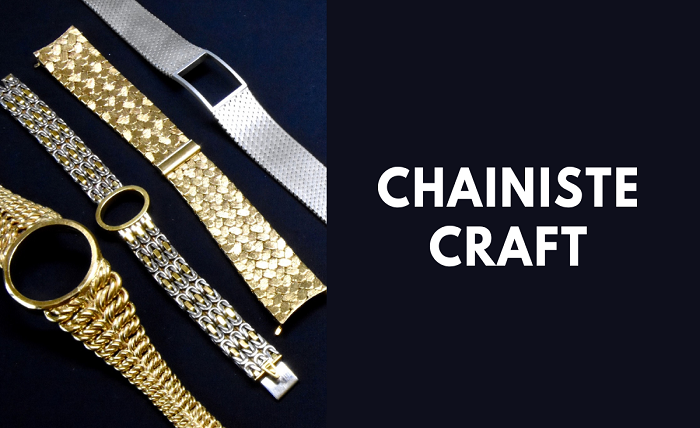A Comprehensive Guide to Chainiste: The Art of Metal Chainmaking

In the realm of jewelry craftsmanship, the art of metal chainmaking holds a unique and significant position. Chainistes, the skilled artisans who dedicate their expertise to this intricate craft, possess a profound understanding of metalworking techniques, precision, and aesthetics. Their creations, ranging from delicate necklaces and bracelets to intricate watch chains and durable utility chains, are testaments to their mastery and enduring legacy.
The Etymology of Chainiste
The term “chainiste” originates from the French word “chaîne,” meaning “chain.” It is believed to have emerged in the 17th century, coinciding with the flourishing period of French jewelry craftsmanship. The term specifically refers to an artisan who specializes in crafting chains from precious metals such as gold and silver, as well as other metals like brass and steel.
The Skillset of a Chainiste
The craft of chainmaking demands a high level of dexterity, patience, and attention to detail. Chainistes undergo extensive training to acquire the necessary skills, including:
-
Metalworking techniques: Chainistes must possess a thorough understanding of metalworking techniques, such as wire drawing, annealing, soldering, and polishing.
-
Precision and accuracy: Chainmaking requires meticulous precision to ensure the consistent size, shape, and alignment of individual chain links.
-
Aesthetic sensibility: Chainistes must have a keen eye for detail and a refined aesthetic sense to create chains that are not only functional but also visually appealing.
Types of Chains Crafted by Chainistes
Chainistes create a diverse range of chains for various applications, including:
-
Jewelry chains: Delicate and elegant chains for necklaces, bracelets, and earrings.
-
Watch chains: Sturdy and durable chains for securing wristwatches.
-
Utility chains: Heavy-duty chains for industrial and agricultural applications.
The Tools and Techniques of Chainmaking
Chainistes employ a specialized set of tools to execute their craft, including:
-
Draw plate: A tool used to draw wire to the desired thickness and diameter.
-
Wire cutters: Precision cutters for shaping and sizing wire.
-
Pliers: Essential tools for manipulating wire and forming chain links.
-
Soldering torch: Used to join individual chain links together.
-
Files and polishing cloths: Tools for refining the surface finish of the chain.
Notable Chainistes and Their Contributions
Throughout history, numerous chainistes have made significant contributions to the advancement of chainmaking techniques and the creation of exquisite chain designs. Among the notable figures include:
-
Jean Duchesne (1640-1727): A renowned French chainiste known for his intricate and delicate chains.
-
Jean-Pierre Rosset (1797-1872): A Swiss chainiste who revolutionized chainmaking techniques by introducing machine-made chains.
-
Peter Brauer (1898-1985): An American chainiste who pioneered the use of new alloys and innovative designs in chainmaking.
The Future of Chainmaking
While chainmaking is a traditional craft with a rich history, it continues to evolve and adapt to changing trends and technologies. Chainistes are embracing modern techniques and experimenting with new materials to create chains that are both aesthetically pleasing and functionally superior.
Conclusion
Chainmaking is an intricate and fascinating craft that has been passed down through generations of skilled artisans. Chainistes play a vital role in the jewelry industry, creating chains that are not only functional but also works of art. Their dedication to precision, aesthetics, and innovation ensures that the art of chainmaking will continue to thrive for centuries to come.
FAQ
Q: What is the difference between chainiste and chainmaker?
A: The terms “chainiste” and “chainmaker” are often used interchangeably. However, “chainiste” is a more specific term that refers to a skilled artisan who specializes in crafting chains from precious metals. Chainmaker is a broader term that can encompass individuals who make chains from various materials and with varying levels of expertise.
Q: What are some of the challenges faced by chainistes?
A: Chainistes face several challenges in their craft, including:
-
The high cost of precious metals: The cost of materials, particularly gold and silver, can significantly impact the profitability of chainmaking.
-
The need for precision and attention to detail: Chainmaking requires meticulous precision and attention to detail to ensure the consistent quality of the chains.
-
Competition from mass-produced chains: Chainistes face competition from mass-produced chains, which are often less expensive but may not offer the same level of quality and craftsmanship.
Q: What are some of the benefits of using handmade chains?
A: Handmade chains offer several benefits over mass-produced chains, including:




